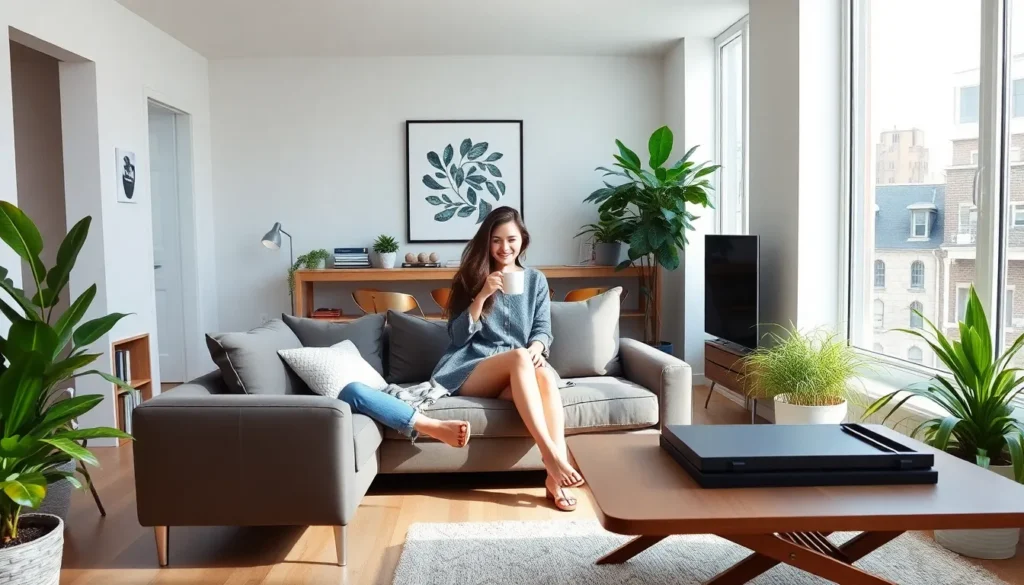Living in a studio apartment doesn’t mean sacrificing style or functionality. We’ve discovered that with the right design strategies and creative answers you can transform even the smallest space into a comfortable and beautiful home that maximizes every square foot.
Studio living has become increasingly popular as more people embrace minimalist lifestyles and urban living. We understand the unique challenges that come with open-plan spaces – from creating distinct areas for sleeping eating and working to maintaining organization without overwhelming the room.
Whether you’re downsizing by choice or working with a tight budget we’ll share proven techniques that help you make the most of your compact space. From clever storage answers and multi-functional furniture to visual tricks that create the illusion of more room these ideas will help you design a studio that feels spacious organized and uniquely yours.
Maximize Your Space With Smart Furniture Choices
Smart furniture selections transform cramped studio apartments into functional living spaces that work harder for you. We’ve discovered that strategic furniture choices can double or triple your available space while maintaining comfort and style.
Invest in Multi-Functional Pieces
Multi-functional furniture pieces serve as the backbone of efficient studio apartment design. Ottoman storage benches provide seating during the day and transform into coffee tables for evening entertainment. Folding dining tables expand when you’re hosting friends but collapse against walls when you need floor space for yoga or exercise routines.
Sleeper sofas eliminate the need for separate bedroom and living room furniture while offering comfortable seating and quality sleep surfaces. Murphy beds fold vertically into wall units during daytime hours and create instant bedrooms at night. Nesting tables stack together when space is tight but separate into multiple surfaces when you’re working on projects or entertaining guests.
Convertible desks double as vanity tables in the morning and workspace areas throughout the day. We recommend choosing pieces that transition smoothly between functions without requiring heavy lifting or complicated mechanisms.
Choose Furniture With Built-In Storage
Built-in storage furniture maximizes every square inch of your studio apartment without adding visual clutter. Storage beds feature drawers beneath the mattress that hold seasonal clothing, extra bedding, and personal items you don’t access daily. Bench seating along windows includes hidden compartments perfect for storing books, electronics, and household supplies.
Entertainment centers with closed cabinets conceal gaming systems, media collections, and office supplies while displaying decorative items on open shelves. Coffee tables with lift-top surfaces reveal spacious compartments for remote controls, magazines, and laptop storage. Armchairs with side pockets keep reading materials and charging cables within easy reach.
Dining sets with bench storage accommodate dinner parties while hiding table linens, serving dishes, and seasonal decorations. We suggest measuring your belongings before purchasing storage furniture to ensure adequate capacity for your exact needs.
Opt for Vertical Storage Answers
Vertical storage answers draw the eye upward and create the illusion of taller ceilings in compact studio spaces. Floor-to-ceiling bookcases display personal collections while storing items you use less frequently on higher shelves. Wall-mounted desks free up floor space for movement while providing dedicated work areas that fold away when not needed.
Tall dressers offer more storage capacity than wide, low alternatives without consuming precious floor space. Hanging organizers transform closet doors into storage centers for shoes, accessories, and cleaning supplies. Floating shelves create display areas for plants, artwork, and frequently used items without requiring floor space.
Ladder shelving units lean against walls and provide multiple storage levels for books, decorative objects, and everyday essentials. We recommend securing tall furniture to walls for safety and choosing pieces that extend close to ceiling height for maximum storage efficiency.
Create Defined Living Zones Without Walls

Open floor plans challenge us to think creatively about space division. We can establish distinct functional areas without compromising the airy feel of our studio apartment.
Use Area Rugs to Separate Spaces
Area rugs work as visual boundaries that define different zones within our studio apartment. Placing a large rug under our seating area creates an instant living room that feels separate from the sleeping space. We should choose rugs that complement each other while maintaining distinct personalities for each zone.
Layering different textures and patterns helps reinforce these boundaries without creating visual chaos. A plush area rug under our bed establishes a cozy bedroom zone, while a smaller accent rug near our workspace signals a productive area. Strategic placement of these floor coverings guides the eye through our apartment and creates natural pathways between spaces.
Size matters when selecting rugs for zone definition. We need rugs large enough to anchor furniture groupings, with at least the front legs of our seating touching the rug’s edge. This technique makes each area feel intentional and properly scaled within our studio’s footprint.
Position Furniture as Room Dividers
Furniture pieces can double as architectural elements that separate our living zones effectively. Bookshelves positioned perpendicular to walls create natural room dividers while providing valuable storage space. We can arrange these shelving units to partially block sightlines between areas without completely closing them off.
Sofas and chairs become powerful space dividers when we position them strategically throughout our studio. Placing our sofa with its back toward the bed area creates a psychological barrier that defines our living room. This arrangement maintains the open feel while establishing clear functional boundaries.
Console tables and storage benches work particularly well as low profile dividers that don’t obstruct light flow. We can position these pieces to create subtle separations between our dining and living areas. Adding decorative objects or plants on top of these furniture dividers enhances their visual impact while maintaining functionality.
Install Curtains or Screens for Privacy
Curtains provide flexible privacy answers that we can adjust based on our daily needs. Installing ceiling mounted curtain tracks allows us to create temporary walls that can be drawn back when we want an open feel. We should choose lightweight fabrics that filter light rather than block it completely to maintain our studio’s brightness.
Room screens offer portable privacy answers that can be repositioned as our needs change. Folding screens with fabric panels create visual separation while adding texture and pattern to our space. We can move these screens to different locations depending on whether we need privacy for sleeping, working, or entertaining guests.
Hanging curtains from the ceiling creates the illusion of taller walls while providing practical separation between zones. Sheer curtains work especially well because they maintain light flow while offering visual privacy. We can layer different curtain weights to create varying levels of separation throughout the day.
Transform Your Walls Into Functional Storage
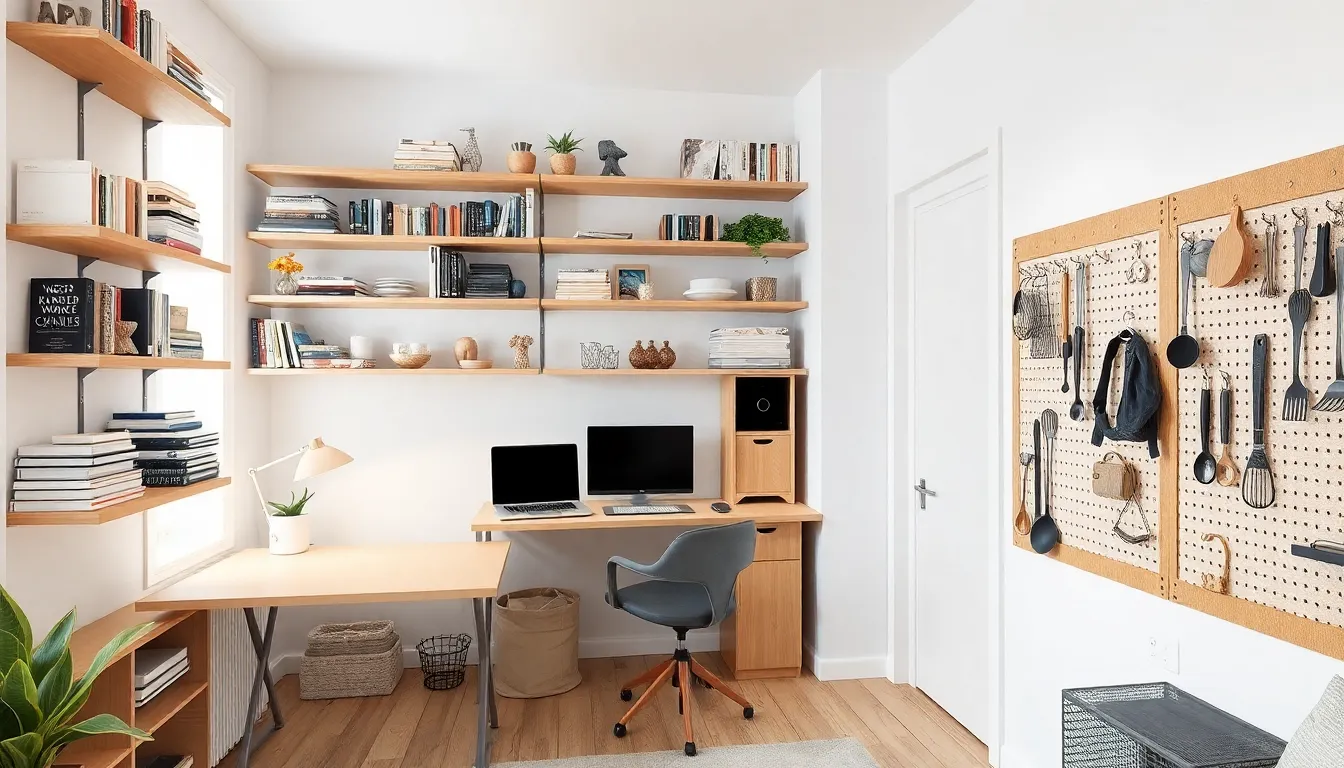
Walls offer the greatest untapped potential for storage in studio apartments. Converting vertical surfaces into functional storage areas maximizes your space while keeping essentials organized and accessible.
Install Floating Shelves From Floor to Ceiling
Floor to ceiling floating shelves create an impressive storage wall that draws the eye upward while maximizing every inch of vertical space. We recommend installing these shelves in a staggered pattern to add visual interest and accommodate items of varying heights.
Books, decorative pieces, kitchenware, and personal belongings find dedicated homes on these shelves without consuming valuable floor space. Deeper shelves near the bottom work perfectly for heavier items like books and storage baskets, while narrower upper shelves display lighter decorative objects.
Spacing shelves 12 to 15 inches apart provides adequate room for most items while maintaining clean lines. Choose materials that complement your studio’s aesthetic, whether that’s sleek white shelving for a modern look or natural wood for warmth.
Use Wall-Mounted Desks and Tables
Wall mounted desks and tables deliver workspace functionality without the permanent footprint of traditional furniture. These pieces fold flat against the wall when not in use, instantly creating additional floor space for yoga, entertaining, or simply moving around comfortably.
Drop down desks work exceptionally well for home offices, providing a dedicated workspace that disappears after hours. Wall mounted dining tables serve double duty as both eating surfaces and extra prep space when cooking.
Installation requires securing these pieces into wall studs to support weight safely. Consider positioning them at heights that work for both sitting and standing use, typically around 29 to 30 inches from the floor for desk surfaces.
Add Pegboards for Versatile Organization
Pegboards transform blank walls into customizable storage systems that adapt to changing needs. Kitchen utensils, tools, accessories, and even lightweight clothing items hang securely from adjustable hooks and holders.
We love how pegboards let you rearrange storage configurations as your needs evolve. Hooks move easily to accommodate new items or seasonal changes, making this one of the most flexible wall storage answers available.
Paint pegboards to match your wall color for a seamless look, or choose contrasting colors to create an accent feature. Standard 4×8 foot panels work well for larger walls, while smaller sections fit perfectly in compact areas like above desks or beside beds.
Optimize Your Lighting to Enhance Space Perception
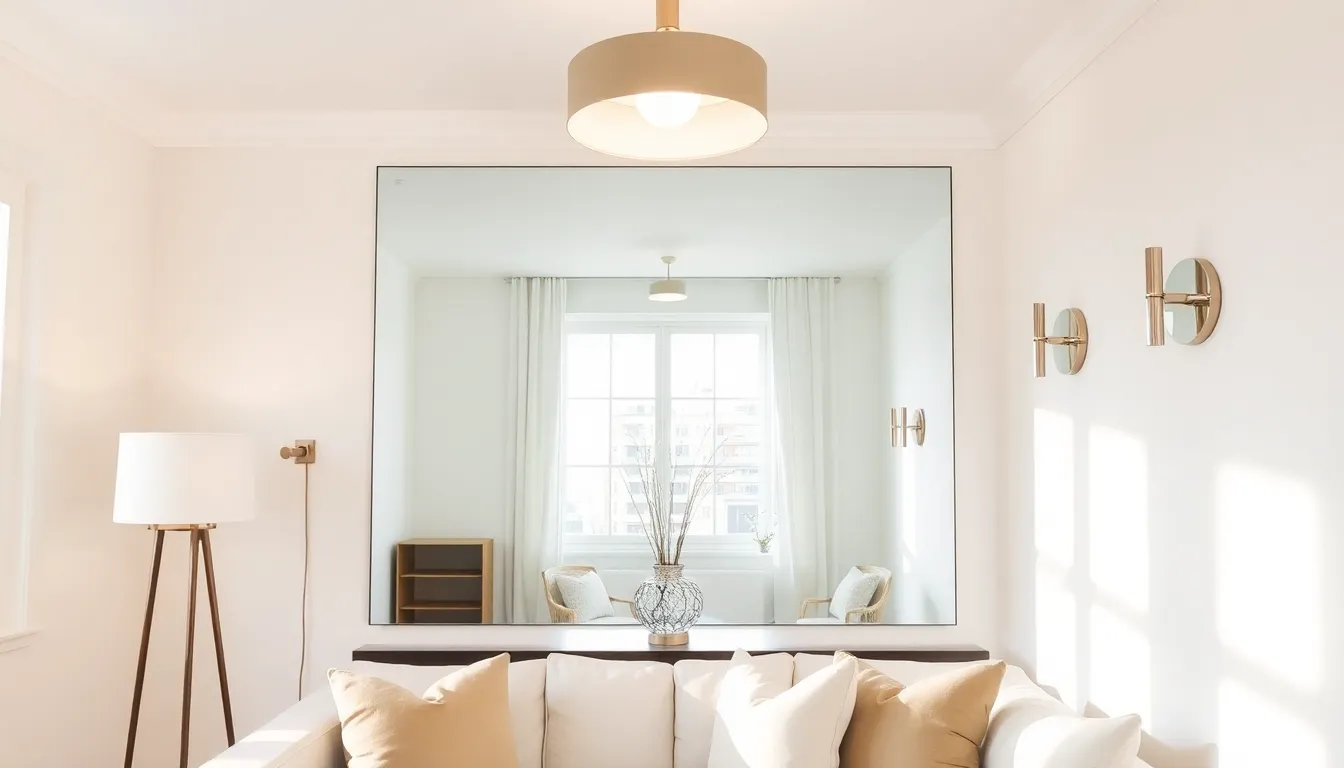
Strategic lighting choices create the most important impact on how spacious your studio apartment feels. We’ll explore three proven techniques that transform cramped quarters into bright, airy living spaces.
Layer Different Types of Lighting
Ambient lighting forms the foundation of your studio’s illumination system. Start with basic ceiling fixtures to provide overall room coverage, then build upon this base with complementary light sources.
Task lighting focuses illumination exactly where you need it most. Position table lamps near reading areas, place floor lamps beside workspaces, and install wall sconces above kitchen counters to create functional lighting zones.
Accent lighting highlights exact features while adding visual depth to your space. Track lights work exceptionally well for directing beams at artwork, architectural details, or textured walls, creating the illusion of expanded square footage through strategic light reflection.
Layered combinations of these three lighting types eliminate harsh shadows and flat appearances. Mix overhead fixtures with table lamps and floor lamps to build dimensional lighting that makes every corner feel intentional and spacious.
Use Mirrors to Reflect Natural Light
Mirror placement opposite windows doubles the natural light entering your studio apartment. Position large mirrors directly across from your brightest windows to capture and bounce sunlight throughout the entire space.
Strategic positioning of mirrors near light sources amplifies their effectiveness significantly. Place mirrors adjacent to table lamps or floor lamps to create multiple light reflection points that brighten dark corners.
Multiple mirror arrangements throughout your studio create an interconnected lighting network. Install mirrors on walls perpendicular to windows, allowing natural light to bounce between reflective surfaces and reach previously shadowed areas.
Choose Light Colors for Walls and Decor
Light colored paints on walls reflect more illumination than dark alternatives, creating immediate space expansion effects. Whites, creams, and pale grays bounce light around your studio while maintaining a clean, modern aesthetic.
Coordinated decor in matching light tones reinforces the spacious feeling throughout your apartment. Select throw pillows, curtains, and artwork in soft pastels or neutral shades that complement your wall colors.
Reflective finishes on furniture and accessories enhance the light bouncing effect. Choose glossy or semi gloss paint sheens, metallic picture frames, and glass decorative elements that catch and redirect both natural and artificial light sources.
Design a Kitchen That Works in Minimal Space
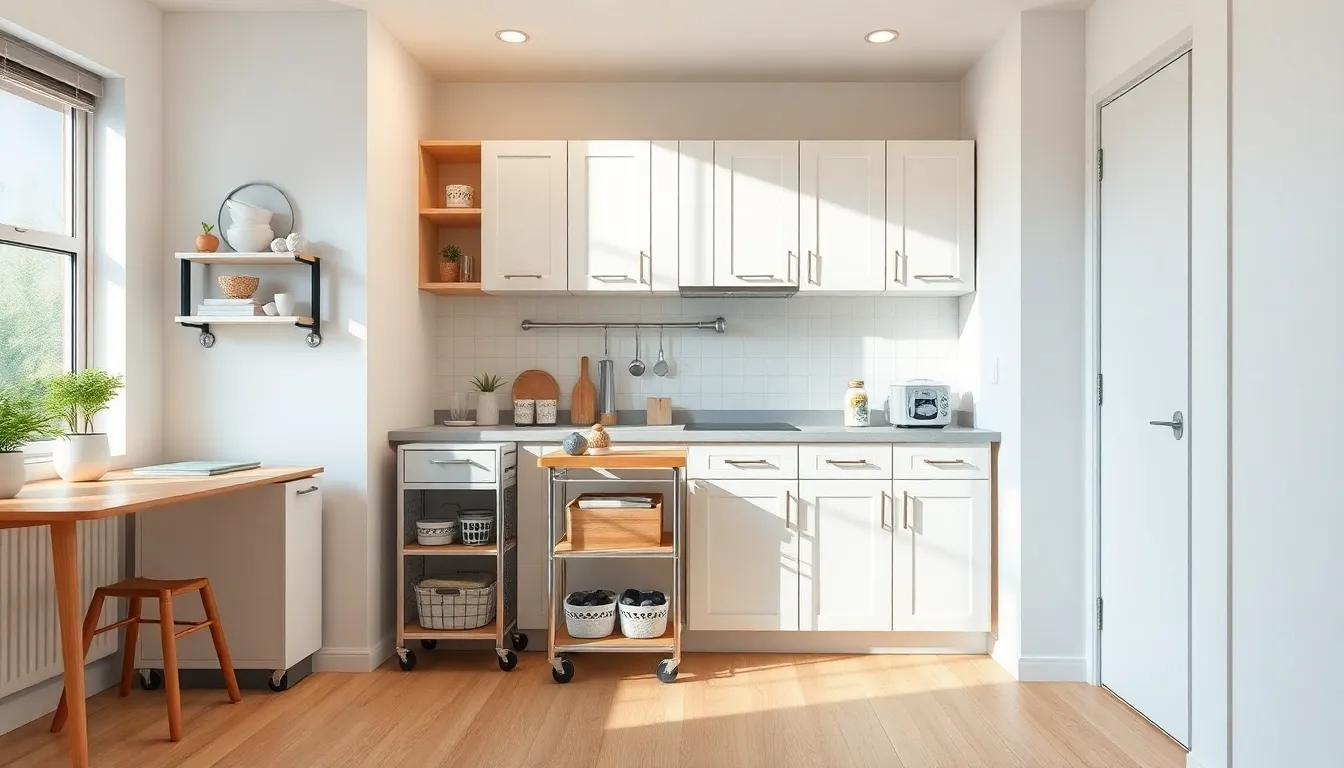
Creating a functional kitchen in your studio apartment doesn’t require sacrificing style or efficiency. We’ll explore smart strategies that maximize every inch of your kitchen area while maintaining the open, airy feel you want.
Use Vertical Cabinet Storage
Vertical cabinet storage transforms your walls into powerful organizational tools without claiming precious floor space. Installing floor-to-ceiling cabinets draws the eye upward and creates the illusion of higher ceilings while providing maximum storage capacity. We recommend choosing white or light-colored cabinets to maintain that spacious feeling throughout your studio.
Wall-mounted upper cabinets work particularly well above counter areas where you need to store dishes, glassware, and pantry items. Consider installing cabinets that extend all the way to the ceiling rather than leaving gaps that collect dust and waste vertical real estate. This approach keeps clutter completely hidden while ensuring everything you need stays within easy reach.
Install a Rolling Kitchen Cart
Rolling kitchen carts provide flexible counter space and storage that adapts to your daily needs. These versatile pieces move wherever you need extra workspace, whether you’re prepping meals, serving guests, or creating temporary dining areas. We suggest choosing carts with multiple tiers that include both open shelving and enclosed storage compartments.
Position your rolling cart near your main cooking area during meal preparation, then wheel it to your living space when entertaining. Many carts feature towel bars, spice racks, and cutting board storage that maximize their functionality. Look for models with locking wheels to ensure stability when you’re chopping vegetables or kneading dough.
Create a Fold-Down Dining Table
Fold down dining tables offer the perfect solution for studio apartments where every square foot counts. Wall-mounted drop-leaf tables attach securely to your wall and fold completely flat when not in use, freeing up valuable floor space for other activities. We recommend installing these tables at standard dining height (around 30 inches) for comfortable seating.
Choose locations near your kitchen area or against walls that don’t interfere with traffic flow through your studio. Many fold-down tables include built-in storage shelves or hooks underneath for dining essentials like placemats, napkins, and utensils. When folded up, these tables can double as decorative wall elements or display shelves for plants and artwork.
Build an Efficient Sleep Area

Your sleeping area deserves thoughtful planning to maximize both comfort and space efficiency. We’ll show you how to create a restful zone that doesn’t dominate your entire studio apartment.
Consider a Murphy Bed or Daybed
Murphy beds transform your studio into a multifunctional space that adapts to your daily needs. Installing one allows you to fold the bed against the wall when not in use, creating additional floor space for other activities like yoga or entertaining guests. We’ve found that daybeds offer similar space-saving benefits while providing comfortable seating during the day.
These versatile sleeping answers work particularly well in studios with limited square footage. Murphy beds come in various sizes and can be customized with built-in storage compartments or desk areas. Daybeds function as sofas throughout the day and easily convert to sleeping spaces for overnight guests.
Use Under-Bed Storage Containers
Under-bed storage containers keep your belongings organized while maintaining a clutter-free environment. We recommend using these containers to store linens, out-of-season clothes, shoes, or extra bedding that you don’t need daily access to. Clear containers allow you to see contents at a peek, while fabric bins offer a softer aesthetic.
Rolling containers make accessing stored items effortless, especially under lower beds. Vacuum-sealed bags work excellently for bulky items like winter coats or comforters. We suggest measuring your bed’s clearance height before purchasing containers to ensure they fit properly underneath.
Create a Cozy Reading Nook
Position a comfortable chair in a quiet corner of your studio to establish a dedicated reading space. We’ve discovered that accent chairs or small armchairs work best for this purpose, providing comfort without overwhelming the room. Adding a small side table gives you space for books, beverages, or reading glasses.
Soft lighting enhances the ambiance and makes your nook more inviting for extended reading sessions. Floor lamps or table lamps with warm bulbs create the perfect atmosphere for relaxation. Decorating with plants around the nook brings warmth and freshness to the space while improving air quality.
Incorporate Clever Storage Hacks Throughout
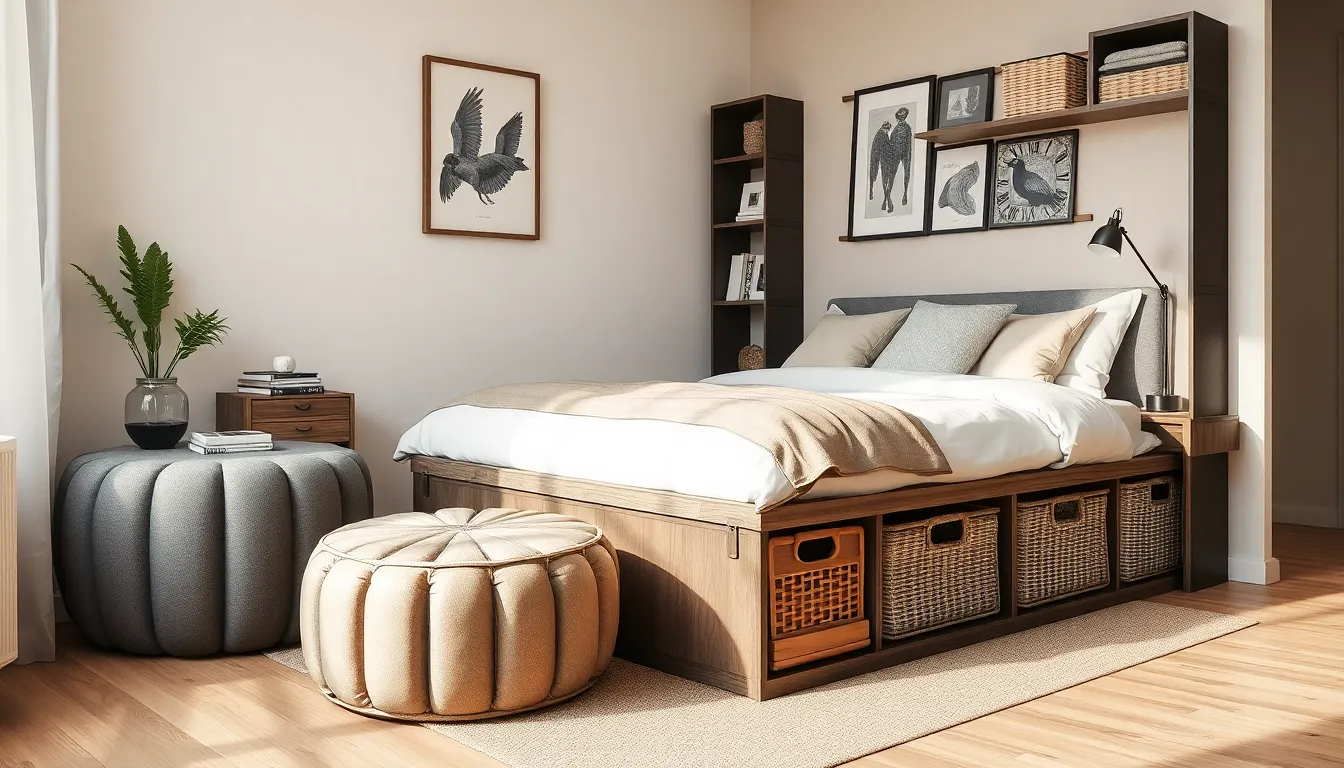
After establishing functional zones and optimizing your wall space, we’ll explore additional storage strategies that maximize every inch of your studio. These clever hacks transform overlooked areas into valuable storage opportunities while maintaining your apartment’s style and flow.
Use Ottoman Storage for Extra Seating
Ottoman storage pieces serve dual purposes in studio apartments by providing comfortable seating and concealing clutter simultaneously. We recommend selecting ottomans with removable tops that reveal spacious compartments perfect for storing blankets, books, or seasonal items. Place these versatile pieces at the foot of your bed to create additional seating for guests while keeping linens organized and accessible.
Round ottoman storage units work particularly well in tight spaces since they eliminate sharp corners that can impede traffic flow. Consider grouping multiple smaller ottomans together to create flexible seating arrangements that adapt to different activities throughout the day. The hidden storage keeps your apartment tidy while ensuring essential items remain within easy reach.
Install Hooks Behind Doors
Door mounted hooks transform unused vertical surfaces into valuable storage real estate without requiring floor space or wall modifications. We suggest installing over the door hook systems on bedroom and bathroom doors to hang jackets, bags, towels, or accessories out of sight. These answers work especially well for items you use daily but don’t want cluttering your living areas.
Behind door storage extends beyond simple hooks to include shoe organizers and hanging storage bags that maximize vertical capacity. Mount these organizers on closet doors to store cleaning supplies, toiletries, or create materials in clearly visible compartments. The back of your entrance door provides prime real estate for coats and bags that guests need quick access to upon arrival.
Repurpose Everyday Items as Organizers
Vintage crates and decorative baskets transform ordinary storage into stylish organizational answers that complement your studio’s aesthetic. We’ve found that old wooden crates work beautifully as nightstand alternatives with built in storage for books and personal items. Stack these crates vertically to create custom shelving units that adapt to your exact storage needs.
Glass and plastic containers repurpose into elegant desk organizers that keep office supplies sorted and visible. Mason jars hold pens and pencils while larger containers store create supplies or kitchen utensils within easy reach. Label these containers to maintain organization while creating a cohesive look that enhances rather than detracts from your studio’s overall design.
Woven baskets slide perfectly under beds or into closet spaces to corral items like extra linens or out of season clothing. Choose containers in materials and colors that coordinate with your existing decor to ensure these practical answers enhance your studio’s visual appeal while solving storage challenges.
Style Your Studio With Space-Expanding Decor
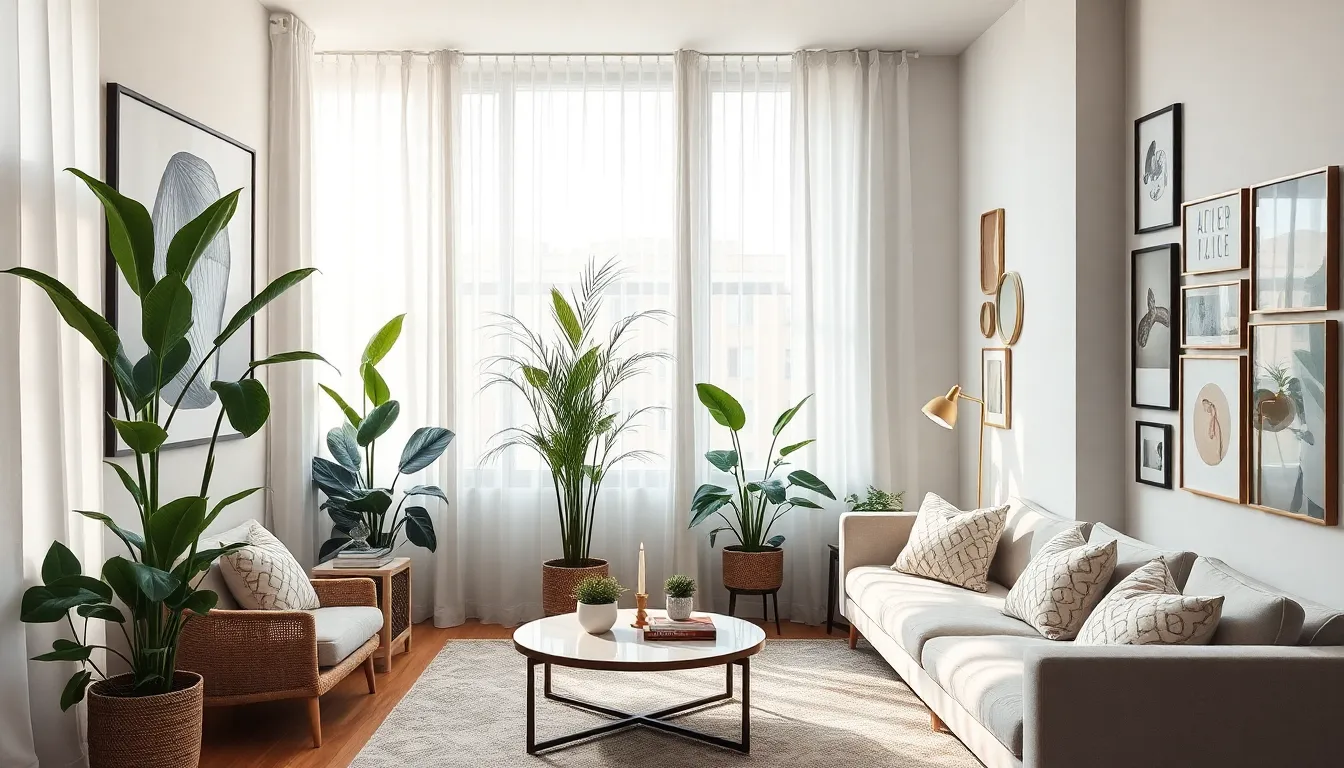
Building on our storage answers, we’ll now explore design strategies that make your studio feel significantly larger than its actual square footage.
Choose a Light and Neutral Color Palette
Light colors serve as the foundation for creating an expansive atmosphere in your studio apartment. We recommend painting walls in soft whites, warm beiges, or gentle grays to maximize light reflection throughout the space. These neutral tones create a seamless backdrop that visually pushes boundaries outward.
Sheer drapery amplifies this effect by allowing natural light to filter through while maintaining privacy. We suggest hanging curtains close to the ceiling and extending them beyond window frames to create the illusion of taller windows and higher ceilings.
Consistent accent colors tie your space together without overwhelming the neutral foundation. Select two or three complementary shades like soft blues, muted greens, or warm terracotta to incorporate through throw pillows, artwork, and decorative accessories. This approach guides attention toward your carefully curated public areas while maintaining visual harmony throughout the studio.
Add Plants to Bring Life to Small Spaces
Greenery transforms sterile studio spaces into vibrant, welcoming environments that feel naturally expansive. We’ve found that plants create visual layers and depth, making compact areas appear more spacious than they actually are.
Tall plants like snake plants or fiddle leaf figs draw the eye upward, emphasizing ceiling height while adding organic vertical elements. Position these statement plants in corners to soften harsh angles and create natural room dividers between your living zones.
Hanging planters maximize floor space while introducing greenery at eye level. We recommend installing ceiling hooks or wall mounted brackets to display trailing plants like pothos or string of hearts, which add movement and visual interest without consuming valuable square footage.
Small succulents and herbs work perfectly on windowsills and shelving units, bringing life to otherwise unused vertical surfaces. These compact plants require minimal maintenance while contributing to the overall sense of vitality in your studio space.
Use Large-Scale Art to Create Visual Interest
Large artwork commands attention and shifts focus away from your studio’s compact dimensions. We recommend selecting pieces that are at least two thirds the width of your furniture or wall space to create proper visual proportion and impact.
Oversized photographs or paintings create focal points that draw the eye into the artwork rather than emphasizing room boundaries. Position statement pieces above your sofa or bed to establish clear zones while adding personality and sophistication to your space.
Gallery walls with multiple medium sized pieces can achieve similar visual weight when arranged strategically. We suggest keeping frames and matting consistent to maintain cohesion while varying artwork sizes and subjects to create ever-changing visual flow.
Mirrors with decorative frames function as both art and space expanding elements. Place these reflective pieces opposite windows to bounce natural light throughout your studio while creating the illusion of additional rooms beyond your actual walls.
Conclusion
Creating your dream studio apartment doesn’t require sacrificing comfort or style for space. With the right approach to furniture selection color choices and storage answers you can transform even the smallest space into a home that truly reflects your personality.
The key lies in thinking creatively about every square foot. By implementing these design strategies you’ll discover that studio living offers unique opportunities for innovation and personalization that larger spaces simply can’t match.
Remember that great design isn’t about the size of your space—it’s about how thoughtfully you use what you have. Your studio apartment can become the perfect blend of functionality and beauty with just a few strategic changes.
Frequently Asked Questions
What is the biggest challenge when designing a studio apartment?
The main challenge is maximizing functionality in an open-plan space without sacrificing style. Studio apartments require smart solutions to create distinct living zones, adequate storage, and a sense of spaciousness while maintaining comfort and personal style in a compact area.
What type of furniture works best in studio apartments?
Multi-functional furniture is essential for studio living. Invest in pieces like ottoman storage benches, sleeper sofas, Murphy beds, storage beds, and coffee tables with lift-top surfaces. These items serve dual purposes and help minimize visual clutter while maximizing floor space.
How can I create separate living zones in my studio apartment?
Define living areas using area rugs, strategic furniture positioning, and curtains for privacy. These techniques help establish distinct zones for sleeping, dining, and relaxing without installing permanent walls that would compromise the open, airy feel of your studio.
What are the best storage solutions for small studio apartments?
Utilize vertical storage with floor-to-ceiling bookcases, wall-mounted desks, and ladder shelving units. Transform walls into functional storage areas with floating shelves and maximize every inch with under-bed storage, built-in furniture storage, and rolling carts for flexibility.
How can lighting make my studio apartment look bigger?
Layer different types of lighting throughout your space and use mirrors strategically to amplify brightness. Proper lighting creates depth and visual interest, while mirrors reflect light and create the illusion of expanded space, making your studio feel larger and more open.
What colors should I use to make my studio feel more spacious?
Choose a light and neutral color palette for walls and major furniture pieces. Light colors reflect more light and create an airy atmosphere. Add personality with consistent accent colors through accessories, artwork, and textiles while maintaining the overall bright aesthetic.
How do I design a functional kitchen in a studio apartment?
Maximize vertical cabinet storage and use rolling kitchen carts for additional prep space and storage. Install wall-mounted shelves, use magnetic strips for knives, and consider fold-down countertop extensions to create more workspace without permanently taking up floor space.
Can I have plants in my small studio apartment?
Absolutely! Plants bring life and freshness to compact spaces. Choose tall plants to draw the eye upward and use hanging planters to create visual layers without taking up floor space. Plants also help purify air and add natural color to your living area.

